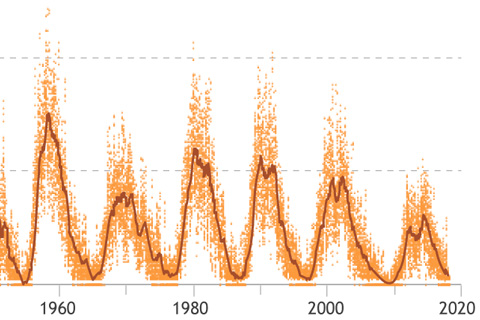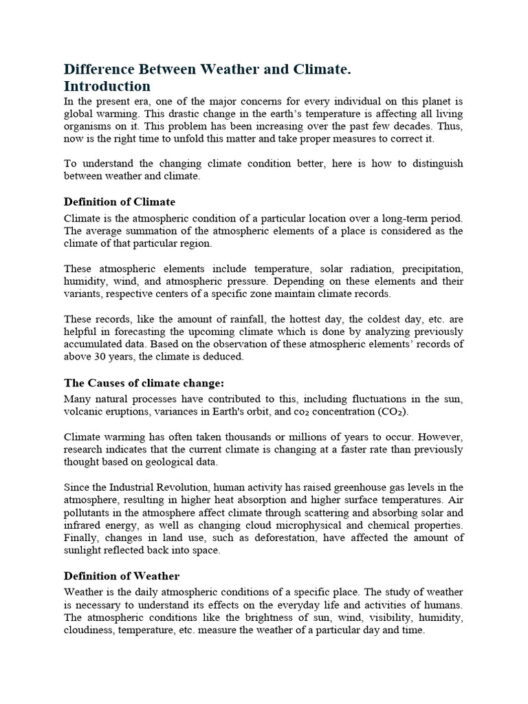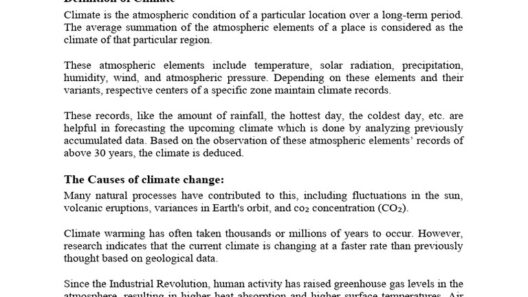Solar radiation is an essential component of Earth’s climate system, serving as the primary source of energy that drives atmospheric processes, ocean currents, and the various ecosystems that populate our planet. Understanding how solar radiation affects climate is paramount for grappling with climate change and formulating effective strategies to mitigate its impacts. This article delves into the intricate relationship between solar radiation and climate, exploring its mechanisms, ramifications, and the complexities that arise in this dynamic interaction.
At the heart of the climate system is the sun, which emits energy in the form of solar radiation. This energy travels approximately 93 million miles to reach Earth, where it is either reflected back into space or absorbed by the atmosphere, land, and oceans. The absorption of solar energy is crucial, as it sets the temperature of the planet and dictates weather patterns.
Understanding the various aspects through which solar radiation influences climate leads us to explore three distinct areas: the greenhouse effect, climate feedback mechanisms, and paleoclimate insights.
Temperature Regulation: The Greenhouse Effect
The greenhouse effect is a natural phenomenon essential for maintaining Earth’s temperature. When solar radiation reaches the Earth’s surface, it is transferred to the atmosphere as infrared radiation. Certain gases in the atmosphere, including carbon dioxide, methane, and water vapor, trap some of this outgoing infrared radiation, preventing it from escaping into space. This process keeps the planet warm enough to sustain life, creating a delicate balance that determines climate conditions worldwide.
However, anthropogenic activities, such as fossil fuel combustion and deforestation, have led to an increase in greenhouse gas concentrations, amplifying the greenhouse effect. This phenomenon results in a rise in global temperatures, causing shifts in climate patterns. Regions previously classified as temperate may experience significant warming, which can lead to more frequent and severe weather events, including droughts, heatwaves, and heavy rainfall.
The ramifications of an intensified greenhouse effect extend beyond mere temperature increases. Rising temperatures strain agricultural systems, disrupt traditional growing seasons, and lead to food insecurity in vulnerable regions. Consequently, understanding solar radiation’s role in regulating temperatures is crucial for addressing the challenges posed by climate change.
Feedback Mechanisms: A Double-Edged Sword
Climate feedback mechanisms play a pivotal role in amplifying or moderating the effects of solar radiation on climate. Positive feedback loops enhance the impacts of initial changes, while negative feedback loops serve to counterbalance them. An example of positive feedback is the ice-albedo effect, where diminishing ice and snow cover, due to increased solar radiation absorption, leads to further warming. As ice melts, it exposes dark ocean or land surfaces that absorb more sunlight, accelerating the warming process.
Conversely, negative feedback mechanisms can help stabilize the climate. For instance, increased cloud formation as a result of rising temperatures can reflect more solar radiation back into space, thus cooling the Earth’s surface. However, the complexities of these feedback loops make it challenging to predict how solar radiation will ultimately impact climate dynamics over both the short and long term.
Delving deeper into these feedback processes reveals their critical significance in climate modeling. Changes in solar radiation levels influence not only temperature but also humidity, precipitation, and wind patterns. These interconnected variables create a web of interactions that shape Earth’s climate zones and ecosystems.
Learning from the Past: Paleoclimate Insights
A thorough understanding of solar radiation’s influence on climate can be enhanced by examining paleoclimate records—information derived from ancient climatic conditions. Through the study of ice cores, tree rings, and sediment layers, scientists can infer past solar radiation levels and their corresponding climate effects.
For example, variations in solar radiation during the Holocene epoch, spanning the last 11,700 years, significantly influenced the growth and distribution of vegetation. Understanding these historical patterns enables scientists to discern more clearly how contemporary solar radiation changes might manifest, as well as identify trends that could emerge over the coming decades due to ongoing climate change.
Furthermore, analyzing paleoclimate data sheds light on the Earth’s natural climate oscillations, such as glacial and interglacial periods, which are intrinsically linked to variations in solar radiation. This geological perspective reminds society of the Earth’s dynamic nature and the importance of distinguishing between natural and human-induced changes.
Final Thoughts: The Future of Solar Radiation and Climate
As we look to the future, understanding how solar radiation affects climate will be increasingly vital for developing informed policy and conservation strategies. Addressing the challenges presented by climate change entails not only reducing greenhouse gas emissions but also fostering a greater awareness of the natural processes that govern our climate.
Investments in renewable energy, particularly solar power, can help alleviate the reliance on fossil fuels, thereby decreasing greenhouse gas emissions while acknowledging the role solar energy plays in the broader climate system. Collaborative efforts across nations, alongside continued research and education, will be key in addressing the intricate relationship between solar radiation and climate, ensuring the sustainability of our planet for generations to come.








